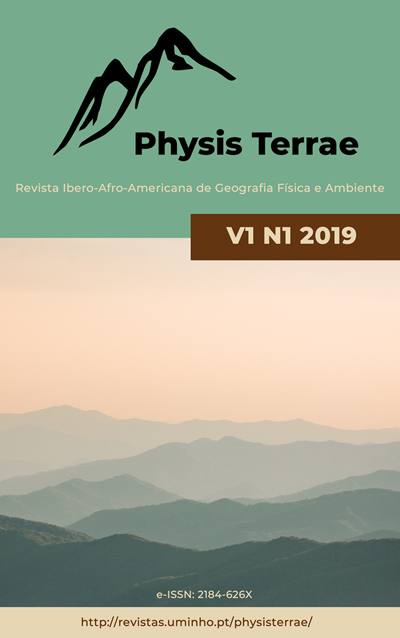Accumulated precipitation in high land between the Tilaran and Central sections, Costa Rica
DOI:
https://doi.org/10.21814/physisterrae.407Keywords:
Precipitation, climatology, five-year periods, mountainous areas, ENSOAbstract
It is analyzed a cumulative total of precipitation every five years, using three climatological stations: Zarcero, Piedades Sur and Montes de Oro in Costa Rica. These locations are selected, since each one is located in different areas of precipitation. In this way it is possible to get an idea of the behavior of precipitation over twenty years. Historical periods every five dry or wet years are identified by the standardized precipitation index method and their trends are analyzed to assess the possible relationship with the ENSO event. Because, those stations are located in very rural areas, only one of them, the first has more than fifty-year data, but to homogenize the records had to consider only twenty years. All stations show some equality in the five-year distribution in precipitation over the course of the period of study (1994-2013). The trend in each season is as follows, Zarcero, they show high levels in the period 2004-2008. Montes de Oro precipitation levels are very regular, albeit with a slight increase in between 2004-2008, but in reality, the increase is very mild. In the case of Piedades Sur shows a strong increase in the rain on the five-year period from 2004-2008. This reflects the existence of a relationship between the area precipitation study regarding ENSO event. As well as the mountainous irregularity.
Downloads
References
Duran, G., Fornet Hernández, E., Hidalgo Mayo A. (2010). Anomalías térmicas positivas y disminución de las lluvias en la comunidad de Guaro Holguín, Cuba. Ciencias Holguín, Revista trimestral, Año XVI, 1-10.
Enfield, D. B., Alfaro, E. J. (1999). Dependence of Caribbean rainfall on the Interaction of the Tropical Atlantic and Pacific Oceans. Journal of Climate, 12, 2093-2103.
Giannnini, A., Kushnir, Y., Cane, M. A. (2000). Interannual Variability of Caribbean rainfall, ENSO and the Atlantic Ocean. Journal of Climate, 13, 297-311.
Hastenrath, Stefan (2002). Variations in Low Latitude Circulation and Extreme Climatic Events in the tropical Americas. Journal of Atmospheric Sciences, 33 (2), 202-215.
Kendall, M. G. (1975). Rank correlation methods. Griffin: London.
Kousky, V. E., Ropelewski, C. F. (1989). Extremes in the Southern Oscillation and their relationship to precipitation anomalies with emphasis on the South American region. Revista Brasileira de Meteorología, 4, 351-363.
Lapinel, B., Centella, A., Gonzáles, I., Fonseca, C., Cutie, V. (2006). Causas de la reciente sequía acaecida en la región oriental de Cuba, Centro del Clima, Instituto de Meteorología, Habana 17, Cuba.
Mann, H. B. (1945). Non-parametric tests against trend. Econométrica, 13, 245-259.
McKee, T. B., Doesken, N. J., Kleist, J. (1993). The relationship of drought frequency and duration to time scales. 8th Conference on Applied Climatology, 179-184.
Moura, A., Shukla, J. (1981). On the Dynamics of Droughts in Northeast Brazil: observations, Theory and Numerical Experiments with a General Circulation Model. Instituto de pesquisas Espaciais, CNPq/INPE, Sao Jose dos Campos, Sao Paulo, Brazil.
Nobre, P., Shukla, J. (1996). Variations of Sea Surface Temperature, Wind Stress, and Rainfall over the Tropical Atlantic and South America. Journal of Climate, 9, 2464-2479. https://doi.org/10.1175/1520-0442(1996)009%3C2464:VOSSTW%3E2.0.CO;2.
Quesada, M. E., Waylen, P. R. (2008). Fluctuaciones bimensuales y decadales en la precipitación de San José, Costa Rica. InterSedes: Revista de las Sedes Regionales, vol. IX, núm. 16, 23-34.
Rivero, A., Ortiz, P. (2005). EL índice NAO como elemento modulador de la variabilidad climática del periodo lluvioso en Cuba. Meteorol. Colomb, 9, 67-74.
Trenberth, K. E., Caron, J. M. (2000). The Southern Oscillation Revisited: Sea Level Pressures, surface temperatures and precipitation. Journal of Climate, 13, 4358-4365.
Waylen, P. R., Quesada, M. (2001). The effect of Atlantic and Pacific surface temperatures on the mid-summer drought of Costa Rica. Cuadernos de Investigación Geográfica, nº. 27, 193-205. http://dialnet.unirioja.es/servlet.
Zhou, J., Lau, K. M. (2001) Principal Modes of Interannual and Decadal Variability of Summer Rainfall over South America. International Journal of Climatology, 21, 1623-1644. http://dx.doi.org/10.1002/joc.700.


